I’ve gathered up the best tips I can find from trusted resources. Here’s your guide for How to Clean Up your Home after Flood Damage.
How to Clean Up your Home after Flood Damage
Hurricane Harvey brought a lot of rain, tornadoes, flooding, power outages, and damage. In fact, we had all of that in just my smallish neighborhood.
Our home and family has been incredibly lucky. Our home is mostly untouched. But many of our friends are dealing with flooding clean up now.
For the last few days, my husband and some friends have been out every day helping friends remove all of the water damage from their homes. So, we are getting a firsthand look at how to clean up your home after flood damage.
Use this Hurricane Prep List to get your house and family ready for a hurricane.
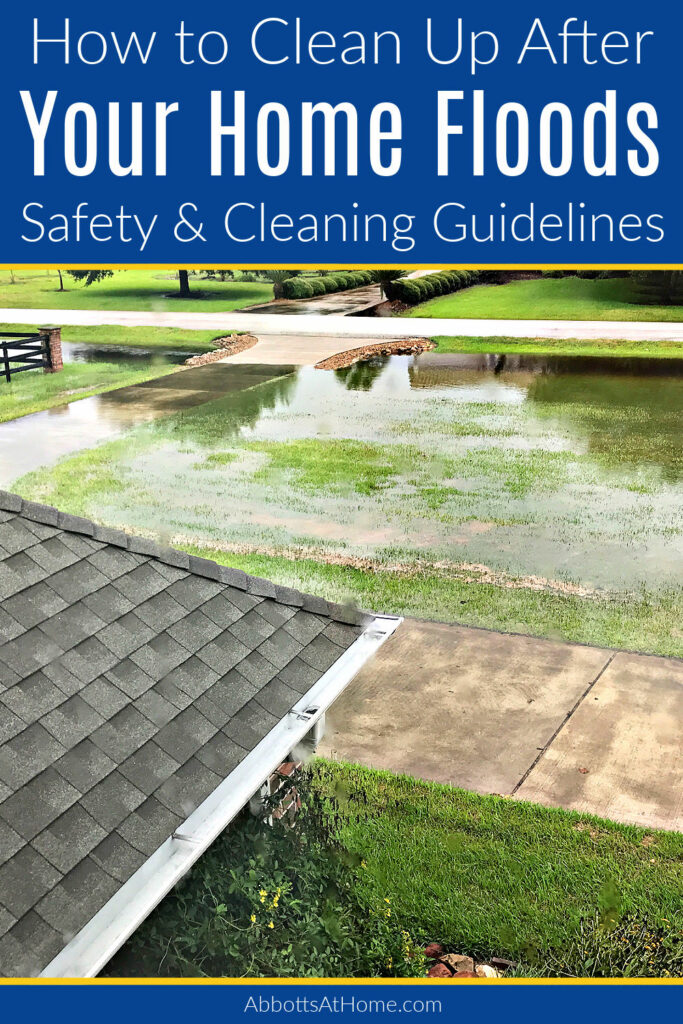
Scroll down to go straight to the guidelines.
Table of contents
- How to Clean Up your Home after Flood Damage
- Our Hurricane Harvey Story
- How Do You Clean Your Home after a Flood
- Cleaning Drywall, Flooring, and Baseboards after Floods
- Protecting the Home While Waiting for Flood Damage Repairs
Our Hurricane Harvey Story
Friday
We lost power almost right away after the storm hit on Friday. That was a long night of Tornado warnings, strong winds, heavy rain, and very little sleep.
The strangest part was waking up to realize that a mini tornado ripped up trees for a 1 mile stretch that included my next door neighbor’s house.
Strange because we never even heard it. Despite having a window open at the time.
My neighbor did say it sounded like a freight train, like they always say. But maybe you have to be pretty close to hear that ‘freight train’. Which would mean you really get almost no warning before a tornado hits. Scary, right?

Saturday
Saturday morning the neighborhood men spent most of the day cutting up the fallen trees and hauling them to our burn pile. Seriously guys, this pile is the size of a small house. I’m kind of afraid to burn it.
Most of the day we sort of felt like Harvey was over, or that we had seen the worst of it. We were in this weird section in the Hurricane that didn’t have much rain for probably 7 hours.
But a few hours after getting our power back, Harvey was back and the rain and tornadoes were too. We lost power for more than a day this time.
Sunday
On Sunday, the flood water covered half of our fields, all of our front yard, and a lot of the backyard.
Houston is an extremely flat city. So, having your home just 3 inches higher can really make all the difference. After his barn flooded, a neighbor brought his horse and her colt to share the high side of our field with our donkeys.
Normally our whole field looks completely flat, but like I said, 3 inches makes all the difference here. I shared this short video of the horses meeting the donkeys on Instagram.


Monday
On Monday, the boys and I evacuated to a hotel on the I-10. Our house was now on the edge of the mandatory evacuation zone for the rising river at the end of our street.
Sundays flood waters had drained, but we assumed they’d be back as the river rose. That the hotel full of evacuated guests and pets, lost power. The kids and I spent the night there, but luckily decided to go back home the next morning.
Later that day, the hotel we were in flooded from the managed releases of the local reservoirs. All of those evacuees were evacuated again. Such a sad situation.
But I have to say, everyone in that hotel was in good spirits and cheerful. Even after we lost power. In fact, the hotel employees had been living there since Friday so that they could be ready to help people. Amazing, right?
Hospital employees, police, emergency workers, nursing home employees, and many others were doing the same. Have you seen the pictures of the National Guard lined up on the hard floors of a school trying to get some sleep?
There are always a few bad people stealing the news time, but the people of Texas, all of America, and even other countries have been amazingly kind, generous, and helpful. Thank you!
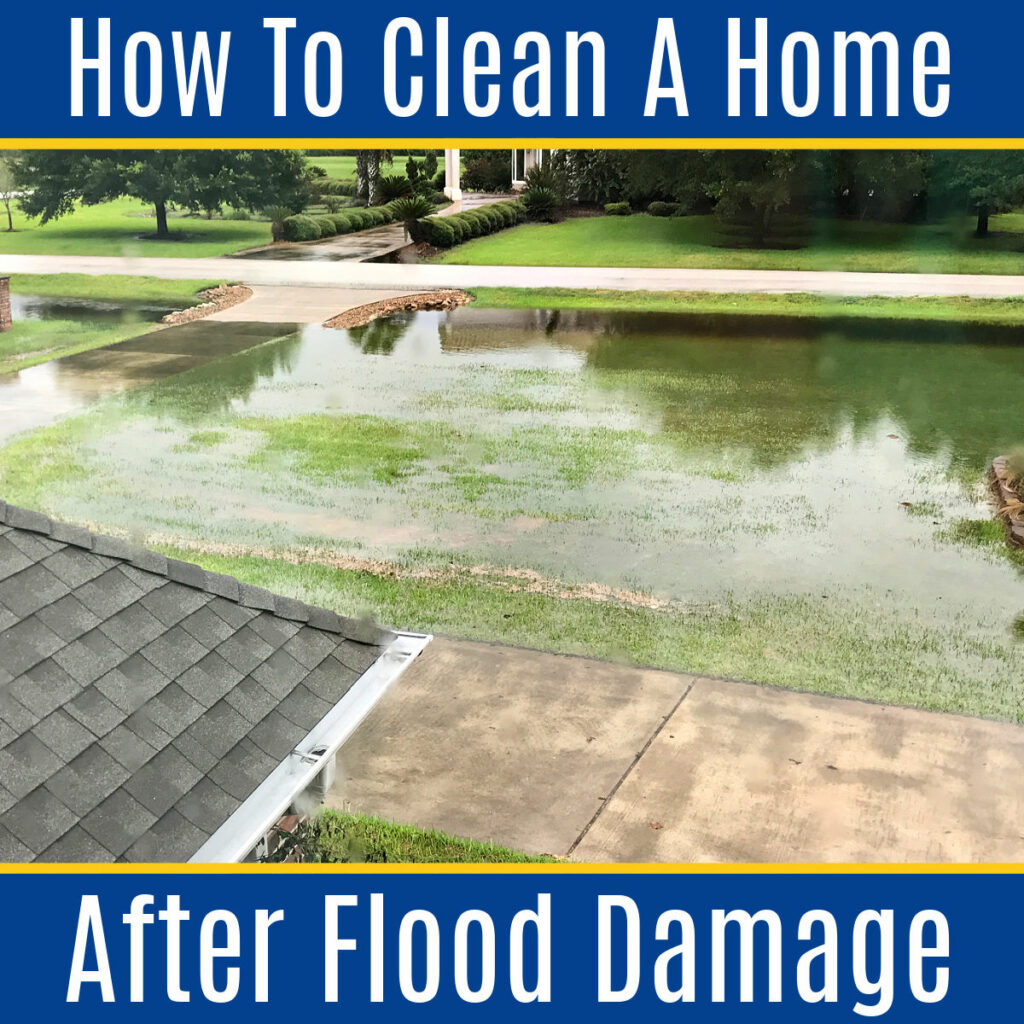
How Do You Clean Your Home after a Flood
These guidelines are very specific to flooding in the United States. Some guidelines may apply to other countries, but others won’t.
Especially since home design, construction materials, and electronics can be very different from country to country. Be sure to follow the guidelines for How to Clean Up your Home after Flood Damage in your country over these. 🙂
Flood Clean Up Safety Guidelines
Flood Damage can cause many safety hazards. Here’s the key guidelines for staying safe when you Clean Up your Home after Flood Damage.
- Do not use portable generators in or near the home, follow generator guidelines for safety. They emit dangerous fumes.
- Always protect yourself. When removing flood damaged material, wear N-95 masks or respirators, rubber boots and gloves, and skin protection. Goggles without air holes are also needed when mold is present. Flood water can carry raw sewage, chemicals, oils, parasites, bacteria, and viruses. And sharp objects can be hiding in silt.
- You may also need to use bug spray with DEET to protect yourself from the mosquito’s.
- Open windows and doors to allow for air circulation. The air quality in the house can be very unhealthy and you’ll want good circulation to increase drying.
- Use fans and dehumidifiers to remove more moisture from the air.
- Beware of animals, snakes, alligators (if in the Southeast) when entering the home.
- Do not light matches or cause sparks, in case of gas leak.
Contact your Insurance Agent After Your House Floods
Before starting any clean up, contact your insurance company. Schedule an adjuster to view your property, as soon as possible.
Ask about their guidelines and requirements for clean up. If your local agent isn’t available, call the national number.
If they recommend something different than what you read here, follow their guidelines. But, as far as I’ve researched, these guidelines meet most standards and situations.
Make a Record of Every Conversation
Document all conversations with the insurance company in a notebook. Always record who you spoke to, what time, and everything they’ve said. Generally, insurance companies are honest, but you have to be prepared for the worst.
Don’t throw anything away until the insurance adjuster sees it. Carpets, rugs, flooring, furniture, appliances, etc…stack them up in the yard. That is your evidence in your case for reimbursement.
Claim everything touched by flood water on insurance, even if you save it (like wood furniture).
Document every single item, not just the big stuff. They will depreciate everything on the claim. So, including every single item helps you get the maximum claim.
Also, if your flooding is part of an ‘officially declared disaster’ check with FEMA for additional services and financial assistance available.
Second, Start Flood Damage Clean Up
One of the most important things to know about How to Clean Up your Home after Flood Damage is that you need to begin clean up quickly.
Cleaning up within 24 – 48 hours of flooding will greatly reduce the spread of mold.
Please note, the EPA recommends that a professional should handle cleanup if the amount of visible mold is larger than about 3′ x 3′.
DO THIS Before Cleaning Anything
Before entering the house, check for structural damage and safety. If there is structural damage, let a professional secure the home and tell you when it is safe to enter.
Turn off the main power and each individual breaker or fuse to the home, even if power isn’t operational. You don’t want it to come back on before an electrician can inspect.
Most important, if your home is still holding water, like in a basement or crawl space, do not enter the home to turn off electricity. You may need to have it turned off at the street, call an electrician to verify.
Gas lines may also need to be disconnected, again consult with a professional to verify.
Before cleaning anything, photograph or take video of all of the damage. Digital works best, since it can be easily copied and sent. Take as many photos as possible.
This will only increase the possible compensation. Really, you can’t take enough pictures. Photograph every wall and item in your home.
Remove Standing Water
Remove any remaining water with a sump pump and/or a good wet vac. Water is heavy, so be careful when lifting buckets or the wet vac.

Sorting Items into Trash, Keep, and Maybe Piles
Mold can develop within 24 to 48 hours. Remove all wet contents as soon as possible. This includes bedding, furniture, curtains, etc. Anything that was touched by the flood needs to be removed and discarded or dried, to check for mold and decide if it can be cleaned, repaired, and salvaged.
Wood and plastic can harbor bacteria, even after cleaning with a bleach solution. Cutting boards and plastic containers or other food contact wood and plastic definitely needs to be thrown away.
Dispose of all food that came in contact with the water. If the air in the home contains mold, dispose of any food above the flood line too. Safety first.Mold spores could be on the outside of those packages.
Store dry, untouched items in plastic containers, like Rubbermaid containers. This will protect the items from damp in the ground. Also, use contractor grade or heavy duty garbage bags for clean up. They are much thicker and stronger than normal bags.
Keep any items you want to keep away from looters. Also, this may sound strange, but protect looters from trying to keep unsafe items, like moldy couches and kids toys, by damaging them. You don’t want a kid playing with a toy that is unknowingly covered in sewage, chemicals, bacteria, or mold spores.
Moisture and mold in the air can damage items, just as much as the flood. Inspect all items above the flood line to determine if they are damaged.
How to Handle Specific Items After Your Home Floods
This FEMA Salvaging After a Flood Fact Sheet can provide additional tips. Another detailed and comprehensive resource on salvaging wet items is the Minnesota Historical Society.
Appliances and Electronics
The State of Pennsylvania provided these guidelines. CAUTION: don’t start up any heating, cooling or other electrical equipment that has come in contact with flood water. Serious damage and life-threatening injury can occur. Make sure all electrical equipment is either unplugged or power to it has been disconnected at the main breaker.
Click the link above to read their full guidelines on appliances after flooding.
Any appliances should be duct taped shut to prevent animals and kids from climbing inside. Especially when the item will be on a curb or in a yard.
Also remember, corrosion may occur after a few weeks of operating. So any item that you thought was fine may stop working 3 or 4 weeks later. Here’s 2 more resources on salvaging flood damaged appliances and Popular Mechanics 4 Rules for Electrical Safety.
Artwork
Any items of sentimental or monetary value will need to be cleaned and evaluated by a professional art restorer.
Books
If something is of value or sentimental, consult a professional restorer. The FEMA fact sheet above recommends drying with paper towels between each sheet. I’m pretty sure they don’t expect you to save that copy of Hunger Games once it’s been soaked in sewage or covered in mold.
Cabinets
Even if the cabinets don’t show damage, the drywall and insulation behind the cabinets will have damage and will still be holding water. You don’t want that turning your bathroom or kitchen into a mold zone.
There may even be water beneath the cabinets still. Remove the cabinets and allow them to dry.
Then treat with a bleach solution to decide if they can be saved. And remove that flooring, drywall, insulation, and the baseboards behind those cabinets.
Duct Work
If you suspect that flood waters entered the ducts or that mold may be in the ducts, contact a professional about cleaning or replacing. Do not run the HVAC. Exposure to airborne mold spores can cause lifelong illness and health problems.
Furniture
Separate out any items that you think can be saved. Decide if the item is worth the time and cost to repair it. Some items also have a sentimental value, which can effect whether or not you want to save it.
Wood that can be saved should be sprayed or wiped with a bleach mixture (3/4 cup of liquid chlorine beach per gallon of water) and allowed to dry. The sun is also great at prohibiting mold growth on wood.
Upholstered items can have deep layers that encourage moisture retention and mold, mildew, or bacteria growth. The fabric and foam will also be holding in any of that dirt and sewage that was in the water.
I personally, wouldn’t keep any of these items, unless it just has a small upholstered area that can be completely removed and replaced, like a chair. Warping in wood is very difficult to repair too.
Hazardous Waste
Items containing oil, pesticide, paint, solvents, gases, and other chemicals; should be disposed of per safety guidelines. Keep them separate from your other trash.
Outside the Home
Use a hose or pressure washer to wash away, mud, silt, and debris. Follow normal guidelines for pressure washing the exterior of a home. You don’t want to spray water behind vinyl siding, in weep holes, or attic vents.
Photos
You may be able to salvage photos. Be sure to keep each photo wet or frozen until you can clean it. If they dry while touching each other, they will stick to each other and it’s unlikely you can get them apart without ruining them.
A plastic bucket or container full of cold water can help keep them wet. Rinse each photo with cool water, then allow it to air dry completely without touching other photos.
Get specific photo type, equipment, and negative restoration tips from the Minnesota Historical Society.
Sump Pump Pits
Sump Pump Pits may need cleaning as well. If they have filled with silt, mud, and debris. Follow suggested guidelines by the manufacturer or hire a professional to get the sump pump back to normal operating conditions.
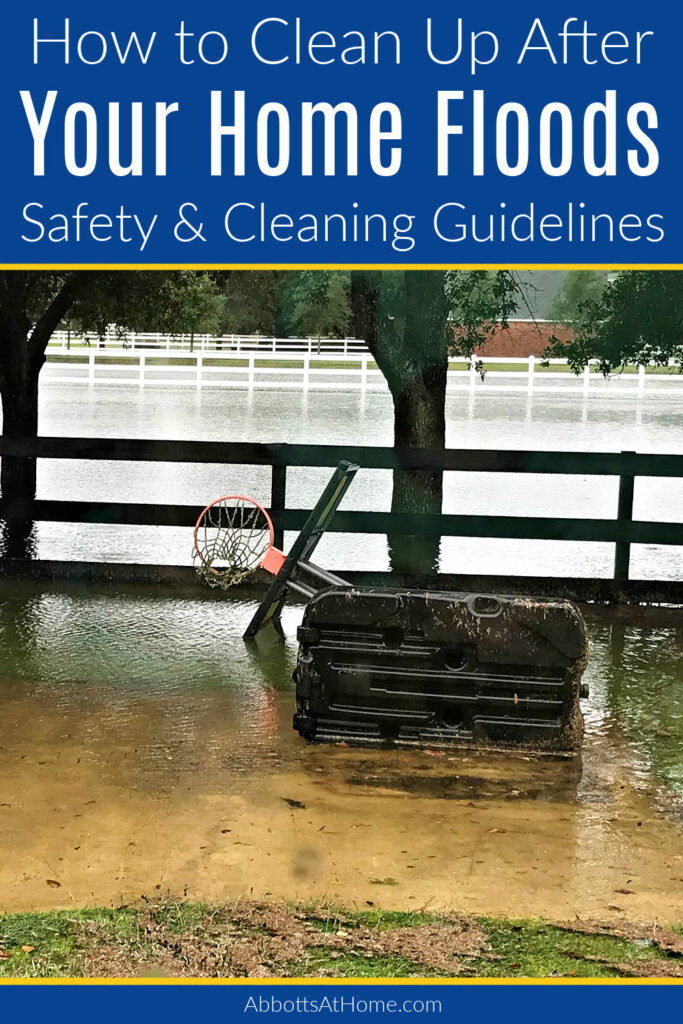
Cleaning Drywall, Flooring, and Baseboards after Floods
Remove all of the baseboards, carpet, hardwood flooring, laminate flooring, and any underlay for that flooring.
Ask you insurance company how best to handle the drywall. I have heard some people recommend cutting 2′ above the waterline, then removing everything below, to prevent creeping mold.
Other people recommend just removing everything 4′ and below, but leaving a small section attached, to show the insurance adjuster how high the water came.
Of course, if you flooded above 4′, then you’d need to remove the drywall up to, and 2′ above the flood line.
After the studs and sub-floors dry, spray with a bleach mixture (3/4 cup of liquid chlorine beach per gallon of water). You’ll want to let that dry and repeat a couple more times.
Some people even follow up those 3 bleach treatments with a spray mold inhibitor too. I’d go the extra step, if it were my home.
Remember, you cannot paint or caulk mold away. It must be removed. It will only continue to grow, even behind strong primers, like Kilz and Zinsser 123.
Related Posts
- Get Your Home Ready For A Hurricane – Inside and Out
- Supplies & Food To Stock Up On Before A Hurricane
- How to Cut Drywall & Hang Drywall – 15 Beginner Tips
- How to Remove Water Stain from Ceiling Without Paint
- How to Fix Water Stains on Ceiling Leaks
- Can You Paint Over Water Stains On Ceiling? Probably
Grab the 16 page free printable version of these tips to get your home ready for a hurricane. This printable also includes my list of food and supplies to stock up on before a hurricane.
Disinfect Your House After Flooding
As a last note, completely disinfect all items and areas of the home you are able to salvage. Remember what I said about that bacteria, sewage, mold, and other hazardous items being in the water.
Protecting the Home While Waiting for Flood Damage Repairs
Unfortunately, knowing how to clean up your home after flood damage isn’t all you need to know. You’ll also need to protect that damaged home.
Protect the home from further damage, from the elements and looters, by putting boards up on broken windows and doors.
If you leave your home exposed to more damage, the insurance company can refuse to pay for that additional damage.
Any wood furniture or items that you want to save should be kept inside at night, to protect from looters.

If you have water stains on your ceiling from smaller leaks, check out how to remove water stain from ceiling without paint. Or this post on Can You Paint Over Water Stains On Ceiling? Probably.
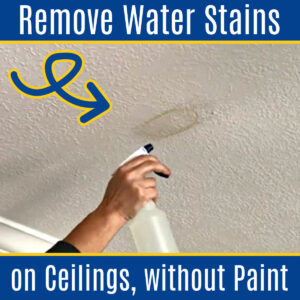
You might also need this tutorial for how to cut drywall and hang drywall for beginners.
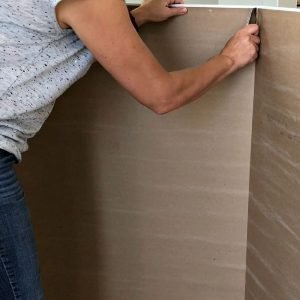
I also LOVE this post for How to Clean Car Seats At Home, the easy way.
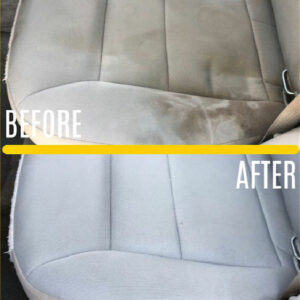
Or How to Clean a Couch at Home. Full of handy tips and alternative cleaners for getting that couch clean!
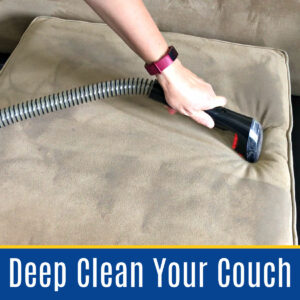
Check out this incredible office chair makeover if you like dramatic before and after pictures. I rescued this chair from the curb.
Sign up for the Abbotts At Home Email Newsletter for updates on this post or if you are a fan of DIY, crafts, and Interior Design.

Stephanie Abbott has been remodeling homes, updating & building furniture, and working on DIY home maintenance and cleaning tips for over 20 years. Her remodeling has been featured in Better Homes and Gardens Magazine. And, her DIY YouTube channel has had more than 8 million views.
Most of the DIY tutorials and videos on this site focus on beginner to intermediate level DIY Projects that can be done in an affordable way without high-end, expensive tools. All of the cleaning tips on this website have been tested in her home.


